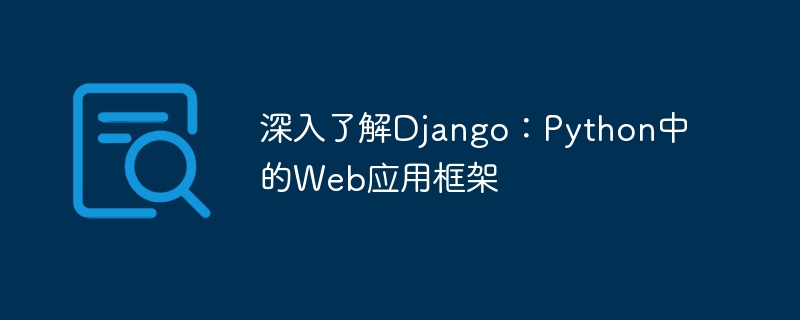

Django is one of the most popular web application frameworks in the Python language. Its purpose is to help developers quickly build high-quality, easy-to-maintain web applications. If you're looking for a quick way to start web development, Django is a great choice.
In this article, we’ll explore some of Django’s core concepts and features, and provide some concrete code examples to help you better understand how it works.
Core concepts of the Django framework:
1. Views
In Django, views are responsible for processing user requests and returning corresponding responses. View functions usually take an HTTP request as a parameter and return an HTTP response object. They can handle the request directly and return a response, or they can hand the request to a template for rendering.
The following is a simple view function:
from django.http import HttpResponse
def hello(request):
return HttpResponse("Hello, World!")This function accepts a parameter named request, which stores all the information of the HTTP request. It returns an HTTP response containing the string "Hello, World!".
To associate this view function with a URL pattern, you need to create a URL pattern in your Django application's urls.py file. Here is the sample code:
from django.urls import path
from . import views
urlpatterns = [
path('hello/', views.hello, name='hello'),
]This URL pattern will match all URLs ending with /hello/ and send them to the hello view function.
2. Models
In Django, models are used to define the data structure of the application. They are responsible for storing application data in the database and provide APIs for reading and modifying the data. Django uses a relational database management system by default, such as MySQL or SQLite, but other database modules can also be used.
Here is a simple model definition:
from django.db import models
class Book(models.Model):
title = models.CharField(max_length=100)
author = models.CharField(max_length=100)
published_date = models.DateField()
def __str__(self):
return self.titleThis model defines a model called Book and stores the title, author and publication date for each book. It also defines a __str__ method that returns the character representation of the model.
To use this model, you need to create a database table in your Django application. This can be done by running the following commands in the terminal:
$ python manage.py makemigrations $ python manage.py migrate
These commands will create the database tables required by the Book model.
3. Templates
In Django, templates are used to generate dynamic HTML pages. They are defined as HTML files, which contain some special tags and variables. Django replaces these tags and variables with actual data and returns the results to the user's browser.
Here is a simple template:
{% extends "base.html" %}
{% block content %}
<h1>{{ book.title }}</h1>
<p>Author: {{ book.author }}</p>
<p>Published on: {{ book.published_date }}</p>
{% endblock %}This template uses Django’s template language to display the title, author, and publication date of a book. It also inherits a base template called base.html and defines the actual content in a block called content.
To use templates, you need to pass data to them in the view function. This can be done in the following way:
from django.shortcuts import render
from .models import Book
def book_detail(request, book_id):
book = Book.objects.get(id=book_id)
return render(request, 'book_detail.html', {'book': book})This view function reads the book with the specified id from the database and passes this object to the book_detail.html template.
To summarize, Django is a powerful and easy-to-use web application framework. It provides many useful features such as models, views, and templates to help build high-quality web applications. In this article, we introduce some of Django's core concepts and features, and provide some concrete code examples to help you better understand how it works.
The above is the detailed content of A closer look at Django: a web application framework in Python. For more information, please follow other related articles on the PHP Chinese website!




